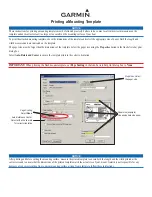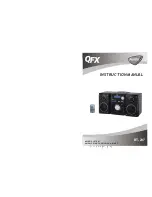
English
4
STACKING AND RACK-MOUNTING RECEIVERS
Multiple AXU4 receivers may be stacked or rack-mounted, as
shown in Figure 9.
SHURE
SHURE
STACKED RECEIVERS
SHURE
SHURE
RACK-MOUNTED RECEIVERS
FIGURE 9. RECEIVER MOUNTING
To stack multiple receivers, attach the rubber feet to the bottom
corners of both units and make sure the bottom receiver is on a
flat, stable surface. Extend antennas fully and point them away
from each other at a 45
°
angle.
To rack-mount one or two receivers, slide the receiver(s) into a
standard audio rack space. Refer to the
Optional Accessories
paragraph for rack mount accessories. If two receivers are
mounted side by side, the outer antennas should be at 45
°
and
the inner antennas should be vertical.
WIRELESS SYSTEM OPERATION
OPERATING YOUR WIRELESS SYSTEM
1. Slide the transmitter MUTE switch to the ON position.
2. Sing, speak, or play your instrument at typical volume levels.
(AXUGD systems: turn the volume control on your guitar or
bass all the way up.) Normal operation is indicated by:
•
Steady glow of one or both yellow DIVERSITY A/B lights.
•
Flickering of the red TRANSMITTER AUDIO PEAK light
when loud sounds are transmitted.
NOTE: If the yellow DIVERSITY A/B lights do not glow, con-
sult the
Troubleshooting Section in this guide.
If the red TRANSMITTER AUDIO PEAK light on the receiver
does not flicker occasionally, refer to the
Wireless System
Adjustments Section.
3. When finished, slide the MUTE switch to MUTE. Then slide
the transmitter POWER switch to OFF. (Muting the transmit-
ter first will help prevent audio thumps that may occur when
powering off the transmitter.)
NOTE: If the DIVERSITY A/B lights do not go out after you
turn off your transmitter, your receiver is picking up an RF sig-
nal from some other source. If you cannot identify and re-
move this source (usually other digital or wireless electronic
equipment nearby), place your receiver in another location.
If external RF sources cannot be avoided, you may need a
wireless system that operates on a different carrier frequen-
cy. Contact your Shure dealer for details.
WIRELESS SYSTEM ADJUSTMENTS
TRANSMITTER AUDIO GAIN ADJUSTMENT
The audio gain control on each transmitter has been factory-
preset at the mid-range position. This produces the best results
in most applications. If the red AUDIO PEAK light on the receiver
does not flicker, the preset gain level may be too low and the audio
gain may need to be increased until a proper signal-to-noise ratio is
reached. This may be necessary for soft singers or talkers, or guitar
or basses with low outputs.
For loud singers or talkers, or instruments with high outputs, the
preset gain level may be too high, causing unwanted distortion.
This condition is indicated by the continuous glow of the red
PEAK light on the receiver during usage.
•
To Increase Gain: Rotate the transmitter gain control clock-
wise with the supplied screwdriver, as shown in Figure 10,
until the red TRANSMITTER AUDIO PEAK light on the re-
ceiver flickers when the guitar is played loudly, or when you
sing or speak in a loud voice.
•
To Reduce Gain: Rotate the transmitter gain control counter-
clockwise, as shown in Figure 10, until the red TRANSMIT-
TER AUDIO PEAK light on the receiver flickers only when
the guitar is played loudly, or when you speak or sing in a
loud voice.
•
To Return Audio Gain to the Factory Setting: Rotate the
transmitter audio gain control counterclockwise as far as it
will go (AXUGD systems), clockwise as far as it will go (AX-
UHD systems), or to mid position (AXU58D and AXULD
systems). See Figure 10.
FIGURE 10. GAIN ADJUSTMENT
ÁÁÁ
ÁÁÁ
Á
Á
ÁÁÁÁ
ÁÁÁÁ
Á
Á
Á
Á
Á
Á
Á
Á
Á
Á
Á
Á
Á
ÁÁ
ÁÁ
ÁÁ
ÁÁ
ÁÁÁ
Á
ÁÁÁ
Á
Á
ÁÁÁ
ÁÁÁ
Á
Á
Á
Á
ÁÁÁ
Á
Á
Á
ÁÁ
ÁÁ
ÁÁ
Á
ÁÁÁ
ÁÁÁ
ÁÁÁ
ÁÁ
ÁÁÁ
Á
Á
+
- 9 V
ÁÁ
ÁÁ
AXU1 GAIN/ATTENUATION SETTINGS
The attenuation switch and the gain control on the AXU1 body-
pack can be used to provide a wide spectrum of gain control
choices. The following ranges are starting points; actual output
levels may vary.
DEVICE
LEVEL
ATTENUATION
SWITCH
SETTING
GAIN CONTROL
SETTING
Lavalier
Microphone
Conversational
Voice
0 dB
HIGH
(clockwise)
Lavalier
Microphone
Projected
Voice
0 dB
MIDRANGE
Headset
Conversational
Voice
0 dB
MIDRANGE
Headset
Projected
Voice
0 dB
LOW
(counterclockwise)
Electric
Guitar
or Bass
Passive
Electronics
–20 dB
HIGH
(clockwise)
Electric
Guitar/Bass
Active
Electronics
–20 dB
MID–RANGE
Electric
Guitar/Bass
Active
Electronics
–20 dB
LOW
(counterclockwise)



























